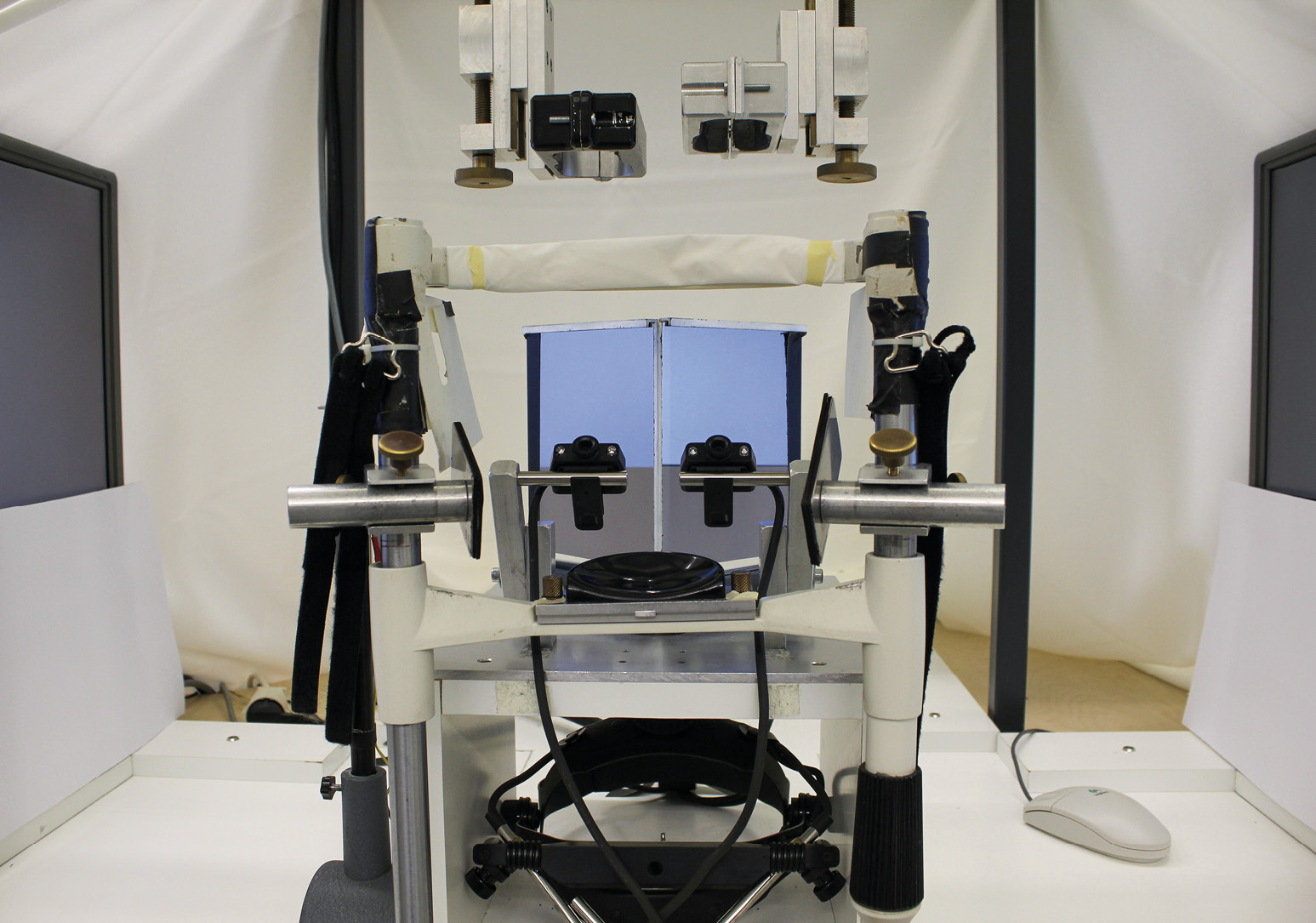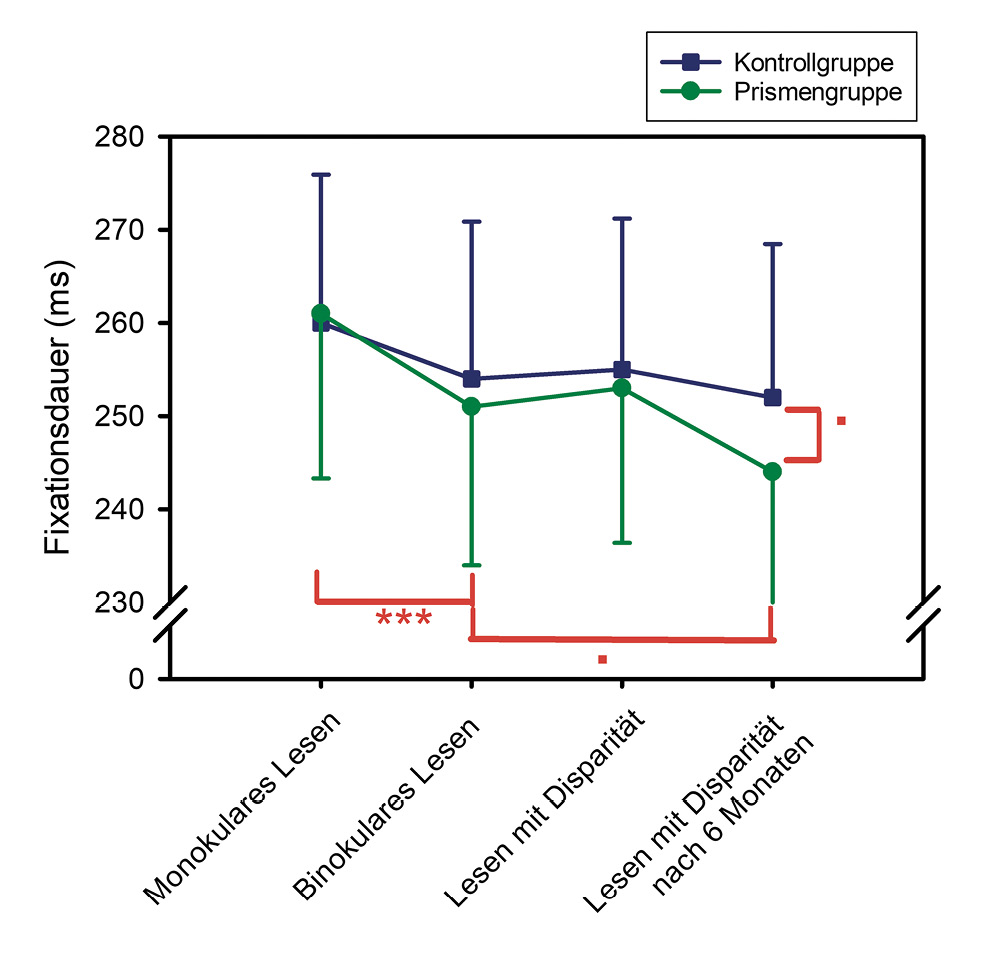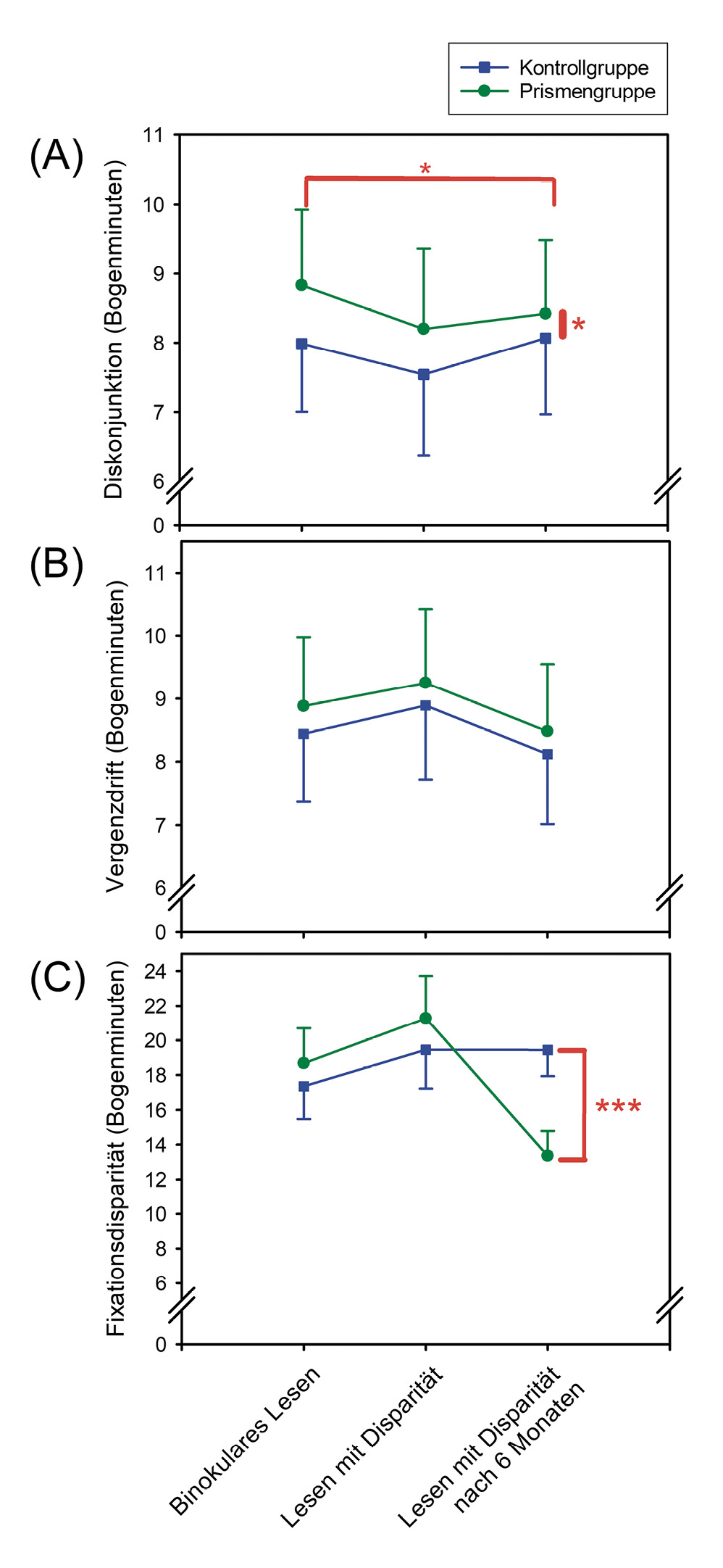Do MCH prisms change the binocular advantage when reading?
Purpose: Reading with both eyes comes with a binocular advantage (shorter total reading times and fixation durations in binocular compared to monocular reading), which results from binocular fusional processes. Binocular advantages in reading typically vary with the amount of individual, horizontal heterophoria and thus, we investigated whether prismatic lenses (measured with the MCH method and worn to compensate any heterophoria) have a short- or long-term effect on binocular advantages when reading.
Material and Methods: We measured the binocular eye movements (Eyelink II) of 54 participants with individual horizontal heterophoria when reading a total of 120 German-language sentences (1) monocularly, (2) binocularly, (3) binocularly with disparity (corresponding to an MCH prism), and (4) binocularly with disparity after 6 months. In the 6-month interval between measurements (3) and (4), 29 participants wore glasses with prismatic corrections, while 25 participants were considered the control group.
Results: Our data showed a clear, significant advantage for binocular reading on all participants. A short-term, individual disparity (analogous to an MCH prism) did not alter this result. An additional tendency towards a greater binocular advantage in the “prism group” compared to the “control group” was only observed after using a prismatic lens for 6 months. Additionally, saccade disconjugacy increased slightly and the objective fixation disparity decreased significantly.
Conclusion: Individual prismatic corrections (MCH) had an effect on some aspects of the binocular coordination during reading and increased the binocular advantage in our heterophoric participants after 6 months of wearing prismatic corrections. This delayed effect on fusion during reading is new and calls for further research.
Introduction
The ability of reading well and quickly (i.e. efficiently) with both eyes requires a stable visual perception of the text produced from the images of both eyes by visual processing and keeping it constant from word to word over gaze jumps (saccades). The fusion mechanisms required for this come up with a binocular advantage: one reads faster with both eyes (binocular) than with only one eye (monocular).1-3 The origins of this advantage lie in the sensory fusion, since, when reading with both eyes, finer visual properties can be detected and differentiated by comparing the two images.4-9 The binocular advantage, however, is more than just simply adding the information contained in the two images: the word-frequency effect (i.e. shorter fixation times for words occurring frequently in a language) varies with the proportion of the binocular reading of the text. This means that, if a person processes a text parafoveally and binocularly, we see a word frequency effect. However, this effect is less in comparison to completely binocular reading, whereas we observe no effect in the case of purely monocular reading.10
The binocular advantage depends on various factors: on the one hand, on environmental factors, such as the contrast of the text, and on the other hand, on individual factors, such as the individual horizontal heterophoria.11 When considering the contrast of the text, it can be said that the visual system for monocular reading requires a higher contrast or a stronger illumination of the text in order to achieve the same reading efficiency as in binocular reading.4-6 Interestingly, it has been shown that the binocular advantage is greater the lower the text contrast: at high contrast, one finds a binocular advantage of about 10% when reading,2, 3, 10-12 while a binocular advantage of about 25% has been observed when the text contrast is reduced by 90%. In the last case, of course, the reading speed also decreases for binocular reading; the relative differences between monocular and binocular reading, however, become significantly greater.2, 13, 14
If we now consider aspects regarding the individual binocular coordination and its influence on the binocular advantage, we find it varies with individual heterophoria.11 This is the objectively measured, individual horizontal heterophoria, which is measured as the angle between the visual axes of both eyes when one eye fixates on a certain point and the other (covered or blinded) assumes its resting position. A general distinction is made between orthophoria, esophoria (i.e. the covered eye deviates nasally) and exophoria (i.e. the covered eye deviates temporally), whereas observations of heterophoria do actually change with the visual task.15-17 In this context, we were able to show in a previous study that participants with a larger heterophoria had a lower binocular advantage.12 We did this by determining heterophoria using three methods (Measuring and Correcting methodology after H.-J. Haase (MCH) at a distance of 6 m, Maddox-Wing test at a distance of 30 cm and objective measurement using an eye tracker at a distance of 60 cm). Our results showed that the relationship between a binocular advantage when reading and the size of the heterophoria was most clearly observed when the heterophoria was determined with the Maddox-Wing test or objectively measured with an eye tracker. However, when the heterophoria was determined with the MCH method, the correlation between a binocular advantage and individual heterophoria was surprisingly not observed.12
The question thus arises why a MCH heterophoria did not correlate with a binocular advantage. The relevant literature reports of people in whom symptoms such as general vision problems or complaints during reading have been reduced by wearing a prismatic lens, although these findings are controversially discussed in the literature.18-21 For example, Dysli, Vogel und Abegg22 could not find any direct effect of prisms on vergence changes when reading. In their study, all participants were emmetropic and showed no binocular abnormalities, and no potential long-term prism effects were recorded. In Germany, Austria and Switzerland, binocular visual complaints and heterophoria are often corrected with prismatic lenses23, and this raises some urgent questions for further studies in the sense of an evidence-based working method. However, we want to briefly outline further findings on heterophoria effects before discussing the research issues of the present study. Some time ago, it was shown that strong exophorias are associated with a greater disconjugacy (i.e. stronger decoupling of both eyes) during saccades11 and that an objectively measured heterophoria correlates with both the objective and the subjective fixation disparity (FD).24, 25 A change in the FD could be observed after only a few seconds of using individual prisms or prisms of different strengths25-27, thus providing further evidence of a direct connection between individual heterophoria and aspects of binocular coordination when fusion is present. We also recently investigated which optometric parameters (heterophoria, vergence and accommodation flexibility, AC/A, near point and symptoms) best explain the variance in binocular fusion variables (fixation disparity, vergence drift, disconjugacy and fixation duration) when reading. Different heterophoria values showed a significant explained variation if the variance of the fixation disparity was to be predicted when reading. If MCH heterophoria was used, only 12% of the variance in the FD could be predicted compared to 24% when using the Maddox-Wing test; the highest prediction of 31% was achieved by the objectively measured heterophoria. In addition, we were able to show that the near point and the vergence flexibility also contribute to the explained variation of the FD. Furthermore, we have shown that AC/A, vergence flexibility and visual complaints are linked to the vergence drift, that the vergence flexibility is connected to the disconjugacy and that visual complaints correlate to the average duration of fixation when reading.28
In summary, it can be said that isolated reports show an influence of prismatic MCH corrections on binocular coordination.25, 28 and that the binocular advantage in reading could also be associated with optometric parameters (see, for example, Jainta and Joss12). To date, however, it has not been investigated how prismatic corrections according to the MCH method affect the binocular advantage when reading in participants with heterophoria in the short or long term (a few minutes or several months of wear). This question was therefore investigated in the present study using a control group design.
Material and Methods
Participants
A total of 54 subjects (19 men, 35 women) aged between 25 and 31 years (mean: 26.1 years, standard deviation: 4.7) participated in this study. All participants had a monocular uncorrected visual acuity of 0.8 (or more) at 60 cm. The cover-uncover test and the TNO stereo test (60" or better) showed no abnormalities. Subjects with vertical heterophoria greater than 1 cm/m or with existing prismatic correction were excluded from the study. The individual correction was also checked by means of retinoscopy and subjective refraction, and, if the measured correction deviated more than 0.5 D (spherical equivalent) from the existing distance correction or the difference in corrected visual acuity between the two eyes was more than 1 visual acuity level, the subjects were also excluded from the study. Thus, all participants had good visual performance and inconspicuous binocular vision.
All participants were informed in writing about the objectives and implementation of the study and signed a declaration of consent. The study was conducted in accordance with the Declaration of Helsinki and approved by the Swiss Association of Research Ethics Commissions (https://www.swissethics.ch/; project number: 2017-01155).
Measurement of heterophoria
This study only included participants who had an absolute heterophoria (MCH prism values) between 0.75 cm/m and 4.50 cm/m at distance. The heterophoria was determined with the measuring and correcting methodology after H.‑J. Haase (MCH) at a distance of 6 m, according to the "Guidelines for the application of the measuring and correcting methodology after H.‑J. Haase" (see www.ivbs.org for details). MCH is a subjective method for measuring heterophoria at distance. The individual tests are presented to both eyes, with some objects only seen by the right eye or only by the left eye as a result of the dissociation by polarisation. Prisms are then inserted in an ascending manner in front of the eyes until the dissociated parts of the test stimuli are perceived as aligned. The resulting prism corresponds to the heterophoria in cm/m.29
The reading task and the study design
The participants silently read a total of 120 German sentences. These were randomly selected from a sentence pool and contained 8 to 13 words each, being thus between 55 and 75 characters long (based on the Potsdam-Sentence-Corpus30). The sentences were grouped in blocks of 5 for each setup conditions. In this way, each sentence was read only once by each participant. The sentences were shown in black Courier New font (size 12) on a white background with a luminance of 24 cd/m2 and an ambient luminosity of approx. 127 lux. The viewing distance of the text was always 60 cm. A monocular calibration was performed before each sentence block and there was a pause between the blocks so that the subjects could relax their eyes for a few minutes. In one third of the all reading presentations, the participants answered a question about the content of the sentence just read (answered with a mouse click) in order to control the understanding of the text. If the rate of wrong answers was higher than 10%, the data of the corresponding person were excluded from the analysis. Only in this way could it be guaranteed that the participants completed the reading task for all conditions at a consistently good level.
All participants were randomly assigned to a prism or control group. The prism group (n = 29) received spectacles with a prismatic correction (in addition to their individual distance correction), which were worn during 6 months of the study. The control group (n = 25) also received glasses with their existing distance correction, but without any prismatic correction. The prismatic correction corresponded to the individual values determined using the MCH method. The mean, absolute heterophoria (regardless of the direction) was 2.1 cm/m in the control group and 2.5 cm/m in the prism group.
In the course of the study, 4 measurements of the binocular eye movements were carried out for each participant during reading: (1) during monocular reading, (2) during binocular reading, (3) during binocular reading with disparity, i.e. with a text offset corresponding to MCH prism correction, and (4) during re-reading with disparity (corresponding to MCH prism) after 6 months of wearing the prismatic correction. The participants did not receive any indication regarding the additional disparity in (3) and (4), nor were they able to recognise it directly in the experimental setup (see Figure 1). The mirror stereoscope used to present the text allowed for an individual adaptation of the text presentations to the measured MCH prism values and also for an seamless presentation of the monocular text (see Jaschinski, Jaschinski, Jainta und Hoormann31 for details). In such a mirror stereoscope5, 6, two half-mirrors are used (positioned perpendicularly to one another) in order to separate the images for the two eyes.

Detection and evaluation of eye movements
All horizontal eye movements during reading were recorded objectively with the video-based EyeLink II (SR Research Ltd, Osgoode ON, Canada; sampling frequency 500 Hz) and separately for both eyes. All calibrations were always carried out monocularly, with the participants fixating a cross which appeared for 1000 ms at one of three horizontal positions (distance: 8 degrees). The monocular presentation (right or left eye) was changed randomly. Further details on the calibration and the course of eye movement measurements have been described in several previous studies and can be found there.11, 32-34
The saccades and fixations were first extracted from all eye movement data via the version signal [(left eye + right eye)/2] and the fixation duration was calculated for each fixation. Next, the vergence signal, i.e. the opposite eye movements [left eye - right eye], was calculated and the following parameters were determined12, 32, 35, 36: the disconjugacy of the eyes during a saccade (in arc minutes), the vergence drift (in arc minutes) as the difference between the vergence at the beginning and at the end of each fixation, as well as the FD at the end of each fixation (as a vergence error, i.e. deviation of the visual-axis intersection from the text plane at 60 cm; in arc minutes). Since we know that the objective FD when reading is slightly in the eso range1, 34, 37, the average individual FD was first calculated for each participant across all binocular reading conditions (conditions: binocular reading, binocular reading with disparity and binocular reading with disparity after 6 months). This mean individual FD was subtracted from all FD measurements of the participant. The FD was then calculated for each fixation and the mean FD was then added again. Thus, for the evaluation of the data, it was possible to compare directly across all participants irrespective of the individual FD (eso or exo) and without individual changes in the FD in the exo direction (from a mostly eso starting position), which would have made the average effects incorrectly too small. In addition, thanks to this calculation method, the absolute size of the FD in the data could be maintained without affecting the relative changes under disparity.
Overall, the data from 54 subjects were analysed, resulting in about 37,200 fixations evaluated during reading. In the two groups (control versus prism group), four different reading conditions (monocular reading, binocular reading without and with disparity and binocular reading with disparity after wearing a prismatic correction during 6 months) were compared with one another. Group and reading conditions were included as fixed factors in a mixed linear model38, 39 in R39, 40, while the sentences and participants were considered as random factors in the model. The estimated fixed effects (b) with their standard errors (SE), t-values and the associated p-values are reported below.
Results
Looking at the binocular advantage during reading, it was found that the mean fixation duration of around 260 ms (SD = 117 ms) for monocular reading decreased by around 10 ms if the participants read binocularly (b = -9.29; SE = 2.56; t = -3.63; p < 0.01; see Figure 2).

A similarly significant change was observed when reading with disparity (b = -7.31; SE = 2.61; t = -2.79; p < 0.01). Furthermore, there was a tendency for the fixation duration to be additionally shortened for the prism group, i.e. the binocular advantage for the prism group increased further after 6 months of wearing the prismatic correction compared with the control group (interaction effect: b = -5.63; SE = 3.804; t = -1.60; p = 0.11). Additionally calculated contrasts (post-hoc comparisons) showed that this difference between the control and prism group when reading with disparity after 6 months was significant (t = 2.57; p = 0.01). The comparison between binocular reading and reading with disparity after 6 months also showed a tendency towards slightly shortened fixation durations with disparity for the prism group (t = -1.76; p = 0.08). We found interesting effects when observing the changes in motor fusion during binocular reading with and without disparity (see Figure 3).

The vergence drift during the fixations remained unchanged over all reading conditions, while the saccade disconjugacy decreased significantly only in the prism group when reading with disparity and after 6 months (interaction effect: b = -0.53; SE = 0.21; t = -2.53; p = 0.01). The same applies for the fixation disparity: while the control group showed no effect when reading with disparity after 6 months, the fixation disparity of the prism group decreased significantly by approx. 8 arc minutes (interaction effect: b = -8.04; SE = 0.43; t = -18.68; p < 0.01). An additionally calculated contrast showed that even this lower fixation disparity when reading with disparity after 6 months significantly differed from the fixation disparity when reading binocularly if only the prism group was considered (t = -12.01; p < 0.01).
Discussion
In the present study we found a general binocular advantage of shorter fixation durations in binocular reading compared to monocular reading.1, 2, 10-12 We were also able to show that wearing a prismatic correction during 6 months tends to further increase the binocular advantage in participants who wore a prismatic correction compared to those without it. This indicates a long-term effect of the prisms: the binocular system of the participants wearing prismatic corrections adapted during the 6 months to the changed visual situation to such an extent, that it tends to work more efficiently when reading than before.41 Such an effect is consistent with observations showing that prisms lead to a reduction in FD.18, 19, 25 However, we could not observe a short-term effect of the prisms (after about 5 minutes). Directly after a binocular reading block, a reading block with disparity before the wearing phase of the prisms showed no difference between the prism and control group. This observation coincides with that of Dysli, Vogel22, whereas other studies have already found an effect in binocular coordination shortly after holding prisms in front of the participants’ eyes.25, 26 In the latter studies, however, the authors did not investigate the change in binocular coordination using prisms for a reading task, but only during a simple fixation task. There could be various reasons for the fact that a short-term effect could not be observed in the present study: on the one hand, the prisms were determined using the MCH method, and, as mentioned above, only slight correlations were found between the binocular advantage when reading and several optometric parameters (vergence and accommodation flexibility, AC/A, near point of convergence, visual complaints).12, 28 On the other hand, it has not yet been possible to show any short-term effects for a real reading task, and it is possible that such a highly automated task is very resistant to short-term changes in, for example, the image quality or in automated, early processes.42
When considering motor fusion, we found that the yoking of the eyes during saccades when reading with disparity tends to be somewhat better (i.e., the disconjugacy decreases slightly in both groups). As published earlier by Jainta und Jaschinski11, the greater the heterophoria, the greater the disconjugacy in binocular reading; thus, our observation may indicate a tendency towards an improvement of the yoking of the eyes when using prismatic correction. In addition, the saccade disconjugacy tends to decrease in the prism group over the duration of the study and tends to increase in the control group. These are small effects, but it seems that a prismatic correction had a positive effect on the binocular coordination of our participants in the long term. At this point, it should be noted that there is little literature on the effect of static prisms on saccade disconjugacy. However, we know from a number of studies on the effect of vergence training that the disconjugacy reacts positively to individual training.43 Interestingly, the vergence drift remains unaffected by the different disparity conditions, although there are indications that the drift reacts to the amount of fusible parts in a visual task (from monocular to completely binocular).1, 11, 44
The most interesting change in motor fusion in our data was undoubtedly found in the fixation disparity. The fixation disparity decreased only for the prism group and only after a 6-month period wearing prismatic correction. Previous studies have already shown that the FD reacts to a wide variety of optometric changes when reading, for example, "larger or smaller heterophoria", "reduced or normal vergence flexibility", "more distant near points" or merely "changed fixation positions in the sentence", meaning to pairs of eyes rotated to different degrees.28, 33, 35, 45 For MCH prisms, it was also possible to show in recent studies that the objective FD changes when prisms are provided, meaning that motor fusion also changes in this case.25, 26
Summarising our present observations, it can be stated that both the binocular advantage and the motor fusion changed in the prism group after wearing prismatic correction during 6 months: the vergence error (FD) clearly decreased and the binocular advantage tended to increase. No major changes were observed in the control group. The clear change in motor fusion coincides with recent findings in connection with non-reading tasks and thus supports both a physiological and non-task-specific effect of the prisms on binocular coordination.22, 25, 27, 28 On the other hand, our observations on the long-term effects of prismatic corrections on the binocular advantage while reading are new and exciting. However, before these are intensively discussed or interpreted for application, these first findings must certainly be replicated.
Conclusions
Wearing prismatic spectacle lenses (according to the MCH method) to correct individual heterophoria (measured at 6 m) showed improvements in binocular coordination during reading (at 60 cm), as well as a slight increase in the binocular advantage. The vergence error of the participants wearing prismatic correction was significantly lower after the wearing phase than before it and the fixation time was somewhat shorter compared to the control group. These observations are new and point to a more long-term effect of prismatic corrections.
Conflict of interest
The authors have no conflict of interest with regard to the methods and devices mentioned in this article. This study was funded by the Swiss National Fund (SNSF; funding no. 320030_172965) and financially supported by the International Association for Binocular Vision (IVBS) for the purchase of spectacle frames and lenses.
